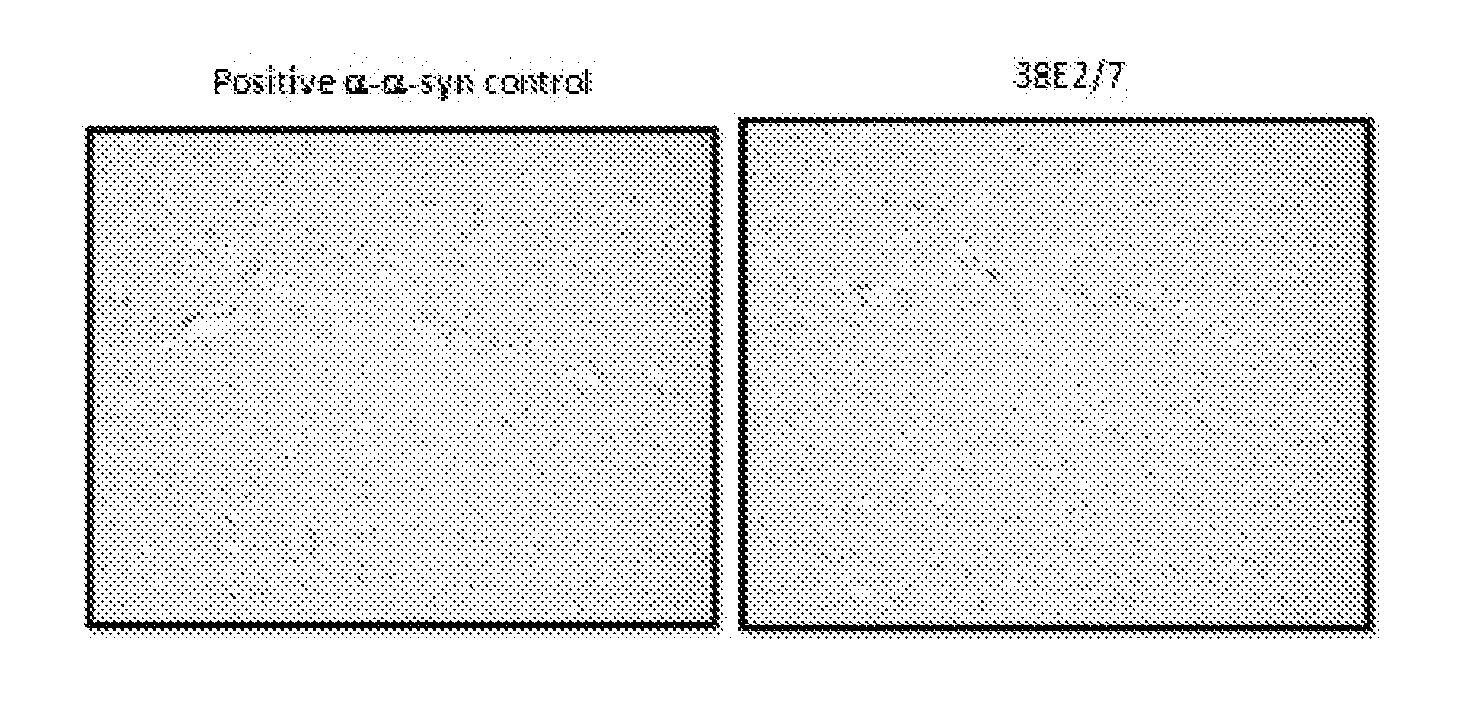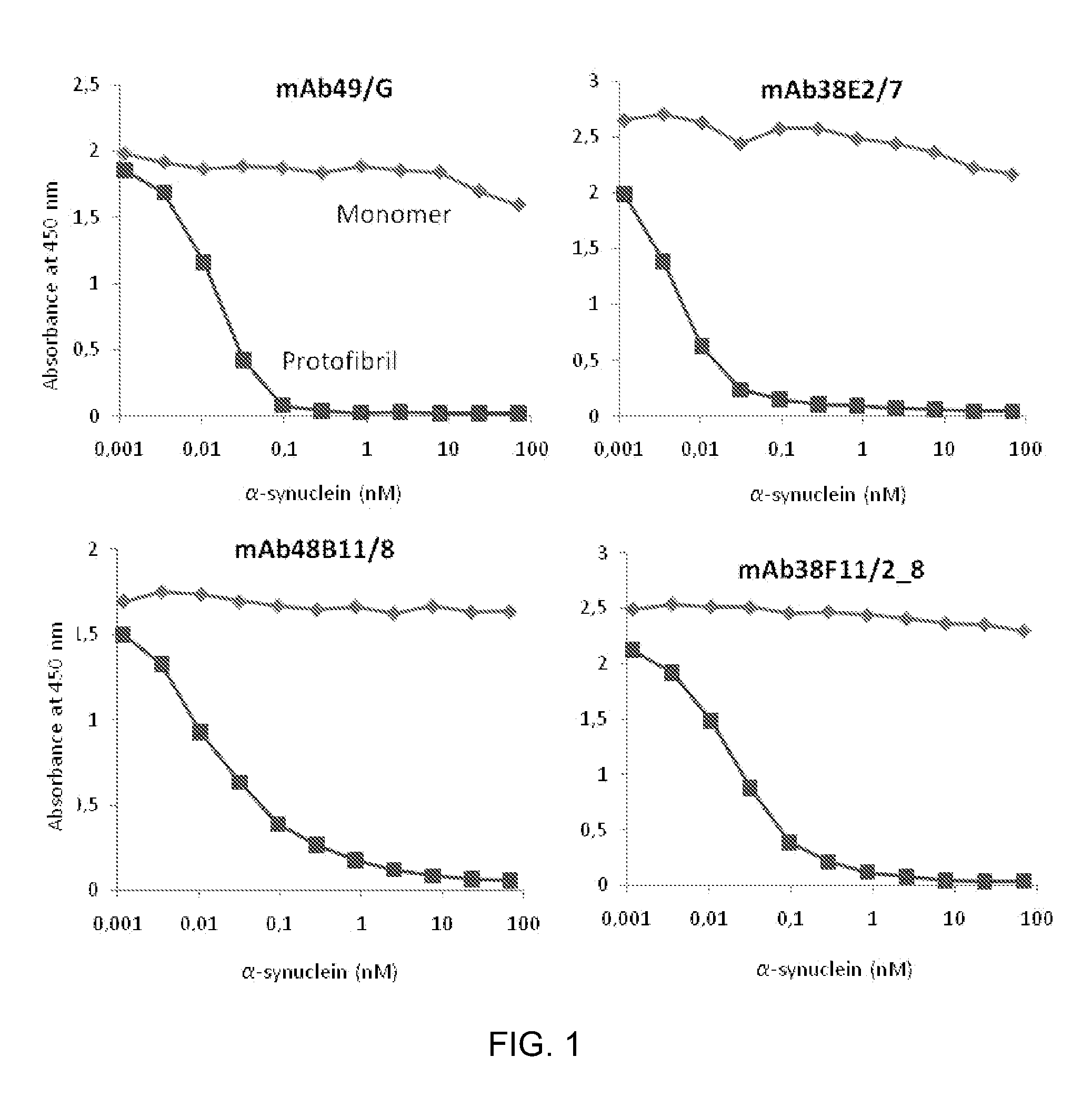Protofibril-Binding Antibodies and Their Use in Therapeutic and Diagnostic Methods for Parkinson's Disease, Dementia with Lewy Bodies and Other Alpha-Synucleinopathies
a technology of protofibril and antibodies, which is applied in the field of protofibril-binding antibodies and their use in the therapeutic and diagnostic methods of parkinson's disease, dementia with lewy bodies and other alphasynucleinopathies, can solve the problems of decreased intracellular -synuclein, dlb patients typically suffer from recurrent falls and visual hallucinations, and oligomeric forms of -
- Summary
- Abstract
- Description
- Claims
- Application Information
AI Technical Summary
Benefits of technology
Problems solved by technology
Method used
Image
Examples
example 1
α-Synuclein Protofibril Antibodies
Immunization / Polyclonal Antibodies
[0082]In the immunization scheme, Balb / C mice are utilized. As antigen, HNE stabilized α-synuclein protofibrils are used. These are produced as previously described (WO 2009 / 133521, incorporated herein by reference), with the following exception: a 60:1 ratio between HNE and α-synuclein is used. For immunization, mice are injected with HNE stabilized α-synuclein protofibrils and adjuvant (e.g. 3-6 times). One booster injection containing HNE-modified α-synuclein protofibrils was carried out prior to the mice being sacrificed. Blood from immunized mice was analyzed for reactivity toward α-synuclein protofibrils and α-synuclein monomers. The specificity of the polyclonal antibody response was analyzed by a direct ELISA. In a typical experiment, a flat bottom high binding 96-well polystyrene microtiter plate is coated with monomeric α-synuclein (unmodified or modified with HNE or other aldehydes), protofibrils / oligomer...
example 2
Amino Acid Sequence of Variable Regions of Heavy Chain (VH) and Light Chain (VL / Vkappa) Monoclonal Antibodies Specific for α-Synuclein Protofibrils
[0086]The amino acid sequences of the variable regions of heavy chain (VH) and light chain (VL), including the CDR regions of the antibodies were determined by RT PCR of mRNA template, followed by DNA sequencing. The amino acid sequences of the variable heavy chain region (VH) and the variable light chain region (VL) for selected antibodies are shown in Table 1. The positions of the CDR regions 1-3 are underlined and shown. The amino acid sequences of the CDR regions form the structural basis for binding human wild type and mutant α-synuclein protofibrils constituting the “pathogenic epitope” of α-synuclein protofibrils.
[0087]The amino acid sequences of the CDR regions 1-3 of the respective VL and VH chains for protofibril specific antibodies according to the invention are shown in Table 1. In Table 2 CDR-sequences of a series of addition...
example 3
Epitope Mapping of α-Synuclein Protofibril Specific Monoclonal Antibodies
[0092]Epitope mappings of the antibodies were performed by immunoblotting on PepSpots membrane. Synthetic peptides spanning the entire sequence (amino acids 1-140) of human α-synuclein were custom synthesized by JPT Peptide Technologies (a subsidiary of Sigma Aldrich, UK) and immobilized on the PepSpots membrane. The 33 synthesised 15-mer peptides were designed with 11 amino acid sequence overlap. The peptides were covalently bound to a Whatman 50 cellulose membrane (Whatman, England) by the C-terminus and have usually an acetylated N-terminus due to a higher stability to degradation. The uncharged N-ac better represents the region in the native antigen then a charged NH3+-group. The results are set forth in Table 3.
TABLE 3AntibodyEpitopeAmino acid residue numbers of SEQ ID NO: 8049 / GYEMPSEE125-13138E2 / 7DNEAYEM121-12738F11 / 2_8LEDMPVDPDNE113-12348B11 / 8DNEA121-12447E7 / 3_47DNEAYEM121-12737D2 / 14LEDMPVDPDNE113-12343...
PUM
| Property | Measurement | Unit |
|---|---|---|
| Fraction | aaaaa | aaaaa |
| Fraction | aaaaa | aaaaa |
| Fraction | aaaaa | aaaaa |
Abstract
Description
Claims
Application Information
 Login to View More
Login to View More - R&D
- Intellectual Property
- Life Sciences
- Materials
- Tech Scout
- Unparalleled Data Quality
- Higher Quality Content
- 60% Fewer Hallucinations
Browse by: Latest US Patents, China's latest patents, Technical Efficacy Thesaurus, Application Domain, Technology Topic, Popular Technical Reports.
© 2025 PatSnap. All rights reserved.Legal|Privacy policy|Modern Slavery Act Transparency Statement|Sitemap|About US| Contact US: help@patsnap.com



